|
The
40th Peachtree Road Race
2009 |
 |
|
It is March 15, 2009, the time is 7:00 AM in Atlanta. I have a hot
cup of coffee, the PC is fired up and I am ready to do a first, the
on-line registration for the July 4th Peachtree Road Race. This is
the 40th year for the Peachtree and the first time the organizers
will automate the registration process, a welcomed change.
In the past, it was getting the Sunday newspaper, filling out the form,
writing a check, putting it in an envelope (note, one per registration per
envelope) and then off to the post office with hopes that it gets to
where it is going to secure a “good low number”. I can just imaging the
work behind the scenes. Organizers getting big bags of mail, opening the
applications, getting the written data into a useable computer
format, making deposit transactions for the 55,000 applications.
Further action must have had to take place including those of
returned checks, unreadable non-complete data, missing documents, etc.
This year it is different with on-line registration. I get through
the sponsors website to the site that actually hosts the entry form.
First name, last name, address, credit card info, etc. all entered into the cells of
the form. Then ENTER. The computer b-a-r-f-s. Cryptic data with the
forms error messages flow back to the screen. What the heck!
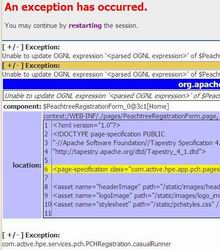 I thought that perhaps I entered something wrong. I get back in
queue and start the form again, this time slowly entering the data
cell by cell, ENTER and b-a-r-f again. I determine that it is not me
but something technical. There must some news on the sponsor website
addressing the technical issues. It was early Sunday morning and I
guess I really was not expecting someone to post a website updates
of problems. No news. I thought that perhaps I entered something wrong. I get back in
queue and start the form again, this time slowly entering the data
cell by cell, ENTER and b-a-r-f again. I determine that it is not me
but something technical. There must some news on the sponsor website
addressing the technical issues. It was early Sunday morning and I
guess I really was not expecting someone to post a website updates
of problems. No news.
Over the next two hours I tried several more times and then finally
at 9:00 AM the application is accepted and the transaction receipt
displays for printing.
Even though it took a couple of hours to work through the technical
issues, it was less time that the trips to the store for the
newspaper and then to the post office. Multiply this out by the
40,000 registrations that were placed by 2:00 PM when the on-line
portion was closed, what a streamlined savings. The Peachtree
committee only needs to handle 15,000 paper applications this year.
June 11, 2009, the Peachtree package is in my mail box. The numbers
are low, Group #3. I should be crossing the finish line more than an
hour later when Group #9 is crossing the start line. I will be home
in time to help James prepare brunch for our Old Ivy gathering.

July 4th 2009 - Peachtree Road Race -
Old Ivy Road
Wes, Kathy, Chris, Brian, Clay, Kim, Mark
 |
|
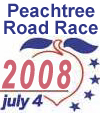
|
The 39th Peachtree Road Race
2008
|
|
|
|
The 4th of July is my favorite holiday!
No presents to buy, no tree to put up, no big meal with football,
just good old summertime activities capped of with fireworks.
We are getting ready for the 39th annual
July 4th tradition in Atlanta, the Peachtree Road Race. This
will be our 4th annual gathering for the road race. The southeast is
suffering from little rain and a drought in 2007. Earlier
this year the City of Atlanta dictated that the organizers of the
Peachtree change the road course with a different finish line.
Piedmont Park, the traditional finish point has suffered from the
drought over the past year and has a difficult time to recover. The experts at the city believes
the 55,000 plus people will challenge the resiliency of the grass.
The race will start at Lenox Mall as usual but will take a route
towards downtown for a new finish. Actually this may work out
better for us since it is closer to the MARTA train line for the return
trip back north to the Buckhead MARTA station at the start line and
the walk home.
On Sunday March 16th, the third Sunday in March, I went to Walmart
and bought three Atlanta newspapers with the Peachtree registration
form. I wrote checks for the $28 with each application.
Within a few days after mailing the forms the checks were deposited
indicating a that we again were going to run. We are looking
forward to the 4th.

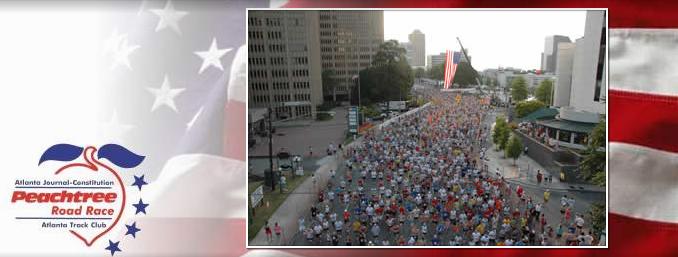
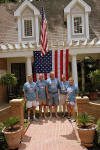 July
4th – ATLANTA, GA - Another year has gone by and another
10K run. Several Fluke Networks employees, family and friends
gather for the 39th running of the Peachtree Road Race on
July 4th in Atlanta, Georgia. The Peachtree, with 55,000
runners, is the world’s largest 10K road race and arguably the best
and most prestigious. For the fourth consecutive year Chris Reed
and James Harper have provided showers and hosted a post run brunch
at their home which is located near the Peachtree starting line. July
4th – ATLANTA, GA - Another year has gone by and another
10K run. Several Fluke Networks employees, family and friends
gather for the 39th running of the Peachtree Road Race on
July 4th in Atlanta, Georgia. The Peachtree, with 55,000
runners, is the world’s largest 10K road race and arguably the best
and most prestigious. For the fourth consecutive year Chris Reed
and James Harper have provided showers and hosted a post run brunch
at their home which is located near the Peachtree starting line.
Pictured from left to right are: Kevin Donnelly, Brian Reed, Chris
Reed, Clay Brooks and Judy Donnelly.
 |
|
|
|




|
The 37th Peachtree Road Race 2006
1
|
|
|
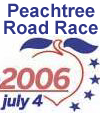 Brian and Kim came down for our second annual 4th of July "new"
tradition that includes the running of the Peachtree. Our home, located near
Phipps Plaza and Lenox Mall where the Peachtree race starts, is a convenient
place for friends to gather that participate in the race too. James made a
brunch loaded with carbs to recharge the runners after the race. Brian and Kim came down for our second annual 4th of July "new"
tradition that includes the running of the Peachtree. Our home, located near
Phipps Plaza and Lenox Mall where the Peachtree race starts, is a convenient
place for friends to gather that participate in the race too. James made a
brunch loaded with carbs to recharge the runners after the race.
The
day before the race we went down to the farm near Madison, GA. Brian and Kim
wanted to see our cows. We made a full day of fishing (actually catching),
eating southern BBQ with the Harper family, driving around the Madison town
square, visiting Ronnie and Sandra’s to see their day old baby chicks that
number over 40,000, corralling and moving Black Angus between pastures,
driving tractors around the field and seeing the local Sunflower Festival.
We had a lasagna dinner that night before the race. Six thirty AM came early
on the fourth. Our friends arrived promptly. The chopping sounds by
helicopters were a buzz in the calm July morning air. The day was going to
be another hot one, the kind of day that reinforces why locals gave the
nickname Hot-lanta to our city.
Brian and I had been assigned running
numbers that were in the last group – Group #9. By the time we got to
Peachtree we were well back in the already swelling crowd of our fellow
holiday runners. The race had started. Group #1, with the world class
running Kenyans was off to Piedmont Park, the location of the finish line.
The only way we could tell that the race had started from our perspective
was that all of the helicopters left the skies above the shopping malls.
An hour and seventeen minutes later Group #9 had moved to the start line.
There was a countdown over the PA system and we were off. For most of the
race all we saw was asses and elbows as the early morning warmth turned to
mid day heat. An hour and twelve minutes later Brian and I crossed the
finish line. Race number two was now over and the tradition continues.
|

|
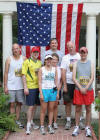
Our July 4th 2006 - our running gang from Old Ivy Road - Brian, Scott,
Kathy, Judy, Kevin, Chris and Wes |

The start of the race - approximately 1 hour and 15 minutes before we
crossed the START - AJC Photo |
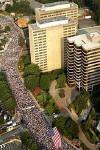
55,000 runners at the start near Lenox Mall -
AJC Photo |

The crowd thins to allow for a running pace - AJC Photo |
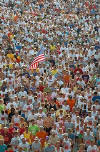
- AJC Photo |

- AJC Photo |

|
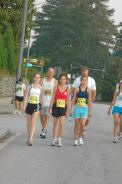
- MARATHONFOTO photo |
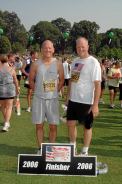
- MARATHONFOTO photo |
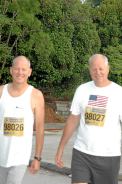
- MARATHONFOTO photo |
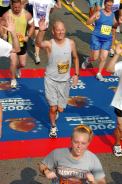
- MARATHONFOTO photo |
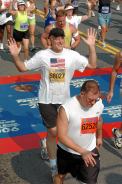
- MARATHONFOTO photo |
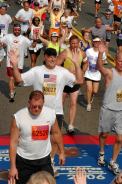
- MARATHONFOTO photo |
|
| |




|
The 36th Peachtree Road Race 2005
1
|
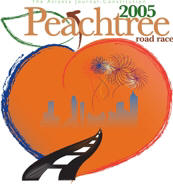 It
wouldn't be July 4th in Atlanta without the Peachtree Road Race. While the
middle of summer may seem to be an unfriendly time to run a 10k race in
Atlanta, this just makes it all the more of a challenge for runners from all
over the world. The Peachtree Road Race is part of the Professional Road
Running Organization (PRRO) Circuit, a prestigious series of road racing
events. In fact, the Peachtree Road Race is the last leg of the "Triple
Crown of Road Racing," beginning with the Credit Union Cherry Blossom 10
miler in the nation's capital, followed by Lilac Bloomsday Run 12k in
Spokane, Washington. It
wouldn't be July 4th in Atlanta without the Peachtree Road Race. While the
middle of summer may seem to be an unfriendly time to run a 10k race in
Atlanta, this just makes it all the more of a challenge for runners from all
over the world. The Peachtree Road Race is part of the Professional Road
Running Organization (PRRO) Circuit, a prestigious series of road racing
events. In fact, the Peachtree Road Race is the last leg of the "Triple
Crown of Road Racing," beginning with the Credit Union Cherry Blossom 10
miler in the nation's capital, followed by Lilac Bloomsday Run 12k in
Spokane, Washington.
The Peachtree Road Race follows a path that
winds through the heart of the city, from Lenox Mall in Buckhead to Piedmont
Park in Midtown Atlanta. It's a huge undertaking mainly handled by the 3500
dedicated volunteers that are up in the wee hours of the morning of the
race, preparing the route so things go smoothly.
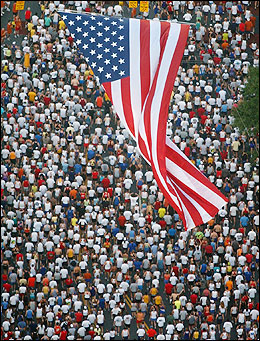 Restaurants and bars along the route offer specials
and many have live entertainment to greet the runners as they pass by. Restaurants and bars along the route offer specials
and many have live entertainment to greet the runners as they pass by.
Every kind of runner, from the amateur to world class champions
participate in the Peachtree Road Race. Those that are able to run the
entire race and cross the finish line receive the coveted official race
T-shirt marking their achievement. As many as 55,000 entrants participate
each year, making it the largest 10k in the world.
The toughest part
of the race for most people is "Heartbreak Hill," the incline that Piedmont
Hospital sits on, as one heads from Buckhead towards Midtown. Many don't
make it past this difficult leg of the race, but good conditioning and
training in hot, humid weather can help you get over the hump. Keeping
hydrated is also extremely important, especially if you are from out of town
and are not used to Atlanta's humid conditions.
The race ends in Piedmont Park, and many runners rest in the ample
shade that the park provides before heading back home. Others chow down at
area restaurants, which are always packed after the event. The Peachtree
Road Race is a fun way to kick off Independence Day in Atlanta, and is a
local tradition that should not be missed.
(from the web Peachtree
Road Race - From Joy Johnston,) |
|
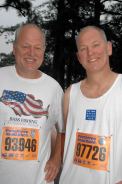
Chris and Brian at the start
|
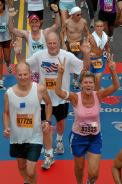
It's downhill to the finish line
|

|
 |
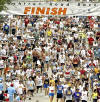 |

|
 |
 |
|
Piedmont Park

|
|
History of the Peachtree Road
Race
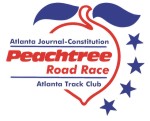 The
Peachtree Road Race is the world's largest 10K road race and arguably the
best and most famous. This year it will again host the PRRO Race of
Champions, the culminating event in the 5-race Professional Road Running
Organization's circuit. The elite field will be drawn from the top
point-earners in the circuit. This will add even more sparkle to an
already glittering event. The
Peachtree Road Race is the world's largest 10K road race and arguably the
best and most famous. This year it will again host the PRRO Race of
Champions, the culminating event in the 5-race Professional Road Running
Organization's circuit. The elite field will be drawn from the top
point-earners in the circuit. This will add even more sparkle to an
already glittering event.
Peachtree's inauguration in 1970 held few
indications of such future glory. The idea for a Fourth of July race down
the city's main thoroughfare germinated the year before when a carload of
Atlanta Track Club members went to Fort Benning for its modest
Independence Day run. On the way home, someone suggested Atlanta should
have its own Fourth of July event; another added it could go down the main
street given the light holiday traffic. Thus is was that approximately 110
runners gathered together at the old Sears parking lot at the corner of
Peachtree Road and Roswell Road and, at 9:30 a.m. on July 4, 1970, headed
downtown towards Central City Park in the first Peachtree Road Race.
The race was but one of a series of small, local races put on by the
Atlanta Track Club. The club had begun in 1964 when a group of
post-collegiate runners joined together with some metro area coaches to
support track and field and road running at the local level. The 1960s
were the pre-dawn of the running boom; those who ran for exercise were
viewed as amusing eccentrics. Road races were small and infrequent, with
runners driving long distances to take part in these low-key competitions.
To help fill this void, the ATC began a modest series of races in the late
1960s, administered informally and attended by a few stalwarts. Peachtree
would become one of this series.
The first Peachtree differed
somewhat from its companion races, even in the beginning, for it attracted
a sponsor, Carling Brewery. That modest support allowed the race to afford
trophies, a luxury not easily funded through the $2 entry fee. Nor did the
budget include T-shirts though it compassed the 15-cent bus fare given to
each finisher to return him back to Peachtree to his car at Sears.
Those who ran the inaugural event recall its jovial lack of pretension.
Founder and race director, Tim Singleton, put the event on with a handful
of volunteers. He, himself, set up registration and started the event. He
then jumped in his car, got to the finish well before the lead runners,
and oversaw the finish and awards.
During the early years, the
course went from Sears in Buckhead to Downtown Atlanta. The runners ran
down Peachtree's far right lane, kept close to the gutter by vigilant
police. At Pershing Point, the course veered onto West Peachtree,
rejoining Peachtree near Davison's (Macy's). The race ended at Central
City Park. There was no water on the course as track and field rules at
the time discouraged such aid for distances 10K or shorter. Spectators
consisted of a few surprised pedestrians walking their dogs. Though
modest, the race nonetheless attracted the local elite: it was won by Jeff
Galloway, to be an Olympian two years later, and Gayle Barron, whose
career would be capped with a 1978 win of the Boston Marathon.
Despite the heat and lack of pomp and frill, the race caught the
imagination of the town's running community, and of those in the
neighboring states. The 1971 Peachtree doubled in size to 198, a growth
which took organizers by surprise. That year they used the Carling money
to buy T-shirts, but had not ordered enough. They decided to give the
shirts to the finishers until they ran out. Those who missed the cut vowed
to return the following year and get one. Many did return, though in some
cases their luck had not improved. Organizers this time had ordered enough
for 250, with the exact design of the year prior, but this time 330 showed
up. Close to a hundred left disappointed, promising to return and finally
earn the shirt.
By 1973, earning the Peachtree shirt had become a
goal of local runners. Its appearance belied its importance. The white
shirt was undated, and was merely reprinted each year with little or no
change, not even a date; those who had succeeded in earning all three
shirts now owned three identical bits of cloth. As the importance of the
shirt grew, so did the number of people who ran. Running as a recreational
activity began to boom in the early 1970s following Frank Shorter's win in
the 1972 Olympic Marathon. The name of this new sports hero, coupled with
the growing popularity of Dr. Kenneth Cooper's book on the benefits of
aerobic exercise, had thousands buying Nike waffle trainers and hitting
the streets. Running was no longer just the activity of the scrawny
eccentric.
The 1974 event doubled again, to 765 finishers. And,
once again, organizers ran out of shirts. In 1975 it fared little better,
when over a thousand runners finished. The 1974 and 1975 now carried the
name Tuborg rather than Carling but were otherwise unaltered.
A
major shift took place in 1976, the first major change in the history of
the race. Carling, with lessening ties to Atlanta, dropped its
sponsorship. The title sponsorship was taken by the Atlanta
Journal-Constitution, largely at the instigation of Jim Kennedy, a runner
and member of the Cox organization's inner circle, the newspaper's owner.
Affiliation with the newspaper brought added coverage and corresponding
popularity. The race organizers, for their part, began inviting the
nation's elite road racers to participate. The field swelled to 2,300;
Olympian Don Kardong won. Peachtree was swiftly becoming among the best
known in the United States. But the shirt still looked the same, with the
newspaper's logo replacing that of Tuborg. There was still no date.
The large fields were straining race organization. The 6,500 who entered
the 1977 race overwhelmed Central City Park. In 1978, the race course was
modified. The Start moved north to Lenox Square and the finish line was
put in front of the Bath House in Piedmont Park. Runners followed the
original course onto West Peachtree. They turned left at 12th Street and
thus entered the Park towards the Bath House. The 1977 shirt also carried
a new look: the familiar peach made its first appearance and as did the
date. By 1979, the field had reached over 20,000. The course by now had
again been slightly altered, with runners entering the Park at 14th
Street. That year, as well, Bob Varsha was hired as the first paid
director.
In 1980, race entries were limited at 25,000. The limit
was set because, at five and half miles, the course narrowed to two lanes
where it entered the Park from 14th Street. Organizers felt congestion
there was too thick to allow more. Thus race numbers remained until 1990.
Though the race limit remained steady, however, interest in the event
continued to flourish and the race closed earlier and earlier. In 1989,
the 25,000 was reached in just 9 days. Those not making the cut bellowed
in anger. Race organizers took heed. The Start was redesigned. Time groups
of 5,000 each were sent from the start at three minute intervals, allowing
the crowd to stretch out sufficiently to ease comfortably through the 14th
Street gate. In 1990, 40,000 ran, with a start lasting 30 minutes. The
race took two weeks to close.
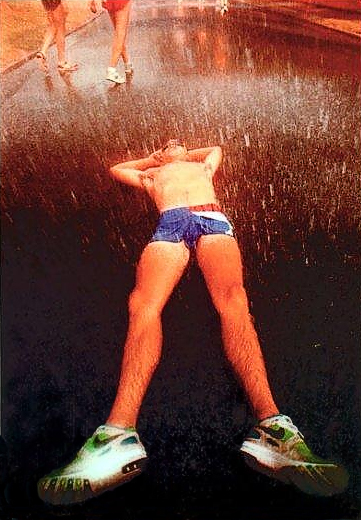 The 1980's saw other changes as well. In the early part of the
decade, the Atlanta Journal-Constitution dropped its sponsorship. It
returned in 1985. And later in the decade, in an effort to better meet the
needs of children, for whom the Peachtree was both too long and too
crowded, the Atlanta Track Club began Peachtree Jr., a fun run 3K for
children 7-12. Run the first Saturday in June, it attracts its limit of
2,500. The 1980's saw other changes as well. In the early part of the
decade, the Atlanta Journal-Constitution dropped its sponsorship. It
returned in 1985. And later in the decade, in an effort to better meet the
needs of children, for whom the Peachtree was both too long and too
crowded, the Atlanta Track Club began Peachtree Jr., a fun run 3K for
children 7-12. Run the first Saturday in June, it attracts its limit of
2,500.
The decade also saw the emergence of Peachtree's Wheelchair
Division. Presently among the most beloved aspects of the race, the
Division took formal shape in 1982. Today, more than 100 athletes take
part, in what has become one of the world's finest wheelchair events,
attracting top international competition. Sponsored by the Shepherd Spinal
Center since its inception, the event has produced several world
record-breaking performances with top contenders covering the 6.2 mile
course in under 20 minutes (the course record for those on foot is 27:04).
During this period, Peachtree also found its niche in Atlanta's effort to
win the bid to host the 1996 Olympics. Bid organizers invited
International Olympic Committee (IOC) organizers to observe the race, and
Peachtree's fourth mile (I-85 overpass to Colony Square) was dubbed the
Olympic Mile, complete with a salutation banner and Olympic theme music
over the sound system. In 1990, Peachtree hosted a breakfast for visiting
IOC members along the Mile. In honor of Atlanta's winning bid, banner and
theme music continue there.
Continued as well has been the race's
popularity. In 1992, the race expanded to 45,000. That year, it closed in
9 days. In 1993, it closed in 6 days, though numbers had expanded to
45,000. And for its Silver Anniversary, it attracted 60,000 entries the
first weekend it opened. The first 40,000 were accepted, the final 10,000
taken from a lottery of those entries postmarked in March (the race opened
March 20). Over 10,000 were rejected.
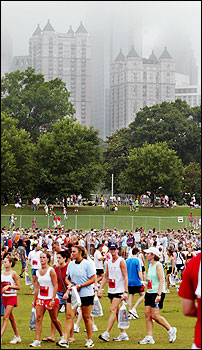 As
anticipated, the 1996 running of the Peachtree was memorable. July 4th was
but two days before the Olympic Village opened to welcome the 10,000
athletes coming to town to participate in the Centennial Olympic Games.
Thirty two Olympians made Peachtree's elite field the most illustrious
ever; it was little surprise that both men's and women's course records
fell, the men's being broken by Kenya's Joseph Kimani in a world best 10K
time of 27:04. As
anticipated, the 1996 running of the Peachtree was memorable. July 4th was
but two days before the Olympic Village opened to welcome the 10,000
athletes coming to town to participate in the Centennial Olympic Games.
Thirty two Olympians made Peachtree's elite field the most illustrious
ever; it was little surprise that both men's and women's course records
fell, the men's being broken by Kenya's Joseph Kimani in a world best 10K
time of 27:04.
The post-Olympic era has little dampened Peachtree's
popularity. When the race opens the third Sunday in March each year, over
60,000 runners routinely vie to enter. In 1998, 55,000 runners were
admitted, up from 50,000 in 1997. Among other changes that year as well,
all runners who qualified for the early time groups by running a certified
10K in 54:59 minutes or under were timed, their names listed in the
following morning's Atlanta Journal Constitution.
In 1999,
Peachtree faced new challenges. Sewer construction in Piedmont Park
required the final mile of the course be rerouted; for the first time
since 1978 the race finished outside the Park. The new finish, on 10th
Street at Charles Allen Drive, is broader and downhill, and has been
greeted by runners with enthusiasm. Thus, the change is likely permanent.
All finish area activity remains in Piedmont Park. As is so often the
case, Peachtree continues to mix new elements into its traditions. |
|
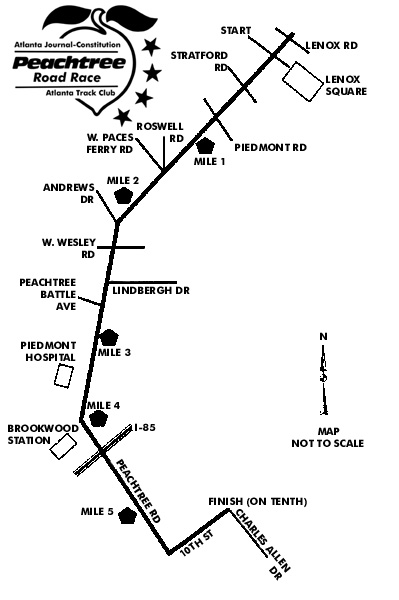
 |
|
|